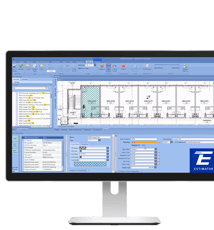How to Manage Preconstruction Teams
Let’s get real for a minute. Managing preconstruction teams has never been easy, especially if your company has multiple offices and teams scattered across the country. There’s no shortage of challenges, from obvious obstacles like ensuring standardization, to less immediately apparent ones like fostering collaboration. With remote work becoming more and more commonplace, the potential roadblocks just keep adding up.
If Your Team Works Remotely
 Work-from-home tip: Designate a separate workspace in your home to eliminate distractions.
Work-from-home tip: Designate a separate workspace in your home to eliminate distractions.Remote work creates further complications, like whether to use Zoom instead of Teams or figuring out the best way to share data so that everyone can access it no matter where they are. Then you still have to throw in planning. When everyone was in the office, a question could be answered in just a couple of minutes, simply by turning around and asking your coworker. But now, with the home office just as commonplace as the corporate one, you’ll find yourself pulling up two or three different Outlook calendars just to try to find that elusive unicorn hour on the one day of the week that works for everyone you need to talk to.
This ultimately creates a domino effect. Your team becomes bogged down in the daily minutiae of juggling the endless logistics of calls, meetings, and emails. You start losing sight of the bigger picture. Your overall productivity suffers and your efficiency goes down. At that point, you barely have the energy to focus on hitting deadlines, much less thinking up innovative solutions to managing a far-flung team. So you start running into three huge challenges:
- Standardization
- Ease of collaboration
- Accessibility
The good news is that you’re not the only person trying to figure out just how to solve these three major problems. There are hundreds of other estimators who have already dealt with these kinds of situations before. Many of these preconstruction professionals are sharing their knowledge to help their peers better understand how to manage their teams successfully as well as efficiently. Although their list of solutions and suggestions could probably fill up a novel, we’ll stick to sharing five:
- Determine the best feedback system for your team.
- Foster collaboration (and make it easier to collaborate) by creating best practices and standards.
- Create a process that helps colleagues determine appropriate mediums for communication more quickly.
- Make sure to strike a balance between too few check-ins and too many.
- When possible, make sure important information is stored in secure but easily accessible areas (ie, a data cloud).
Want to know more? We thought you might. So keep reading to take a closer look at these five tips and learn how they can transform the way you manage your preconstruction team.
Determine the best feedback system for your team.
 Establish the best way to communicate between team members to eliminate confusion and save tim
Establish the best way to communicate between team members to eliminate confusion and save timThis is a tip straight from one of our favorite estimators, Jan Beran at Beckenhauer Construction. When you’re dealing with a team in different regions and time zones, it’s only going to add another layer of confusion if you use too many different systems for feedback. For example, maybe someone prefers to email their feedback, while another wants to share comments by hopping on a call. Setting one universal method of feedback cuts down on time, increases clarity, and lets your team function smoothly.
Create a process that helps colleagues determine appropriate mediums for communication more quickly.
Tying into the previous point, another issue that makes managing preconstruction teams difficult is decision paralysis. Does this question warrant a full-on Zoom meeting, complete with audio and video? Would it be easier as a quick text sent over Microsoft Teams? Too often, teams can err on the side of caution, and the next thing you know your schedule is being overtaken by meetings that probably should have been emails.
It’s not always easy to know when a certain medium is appropriate, though. So take a moment to sit down and think of a simple process any team member can follow to avoid wasting critical time. For example, if you can’t explain the problem in three sentences on a Teams message, it needs to be a call.
Foster collaboration (and make collaboration easier) by creating best practices and standards.
 Whether in person or on a Zoom call, foster ways for all your offices to communicate effectively.
Whether in person or on a Zoom call, foster ways for all your offices to communicate effectively.As you can tell, standardization is absolutely critical to successfully managing a preconstruction team. This is especially true when it comes to collaboration. There may be projects that land on your desk that require help from another office. That doesn’t sound like a problem on the surface, but let’s say that your office uses Excel and their office uses WinEst. There’s going to be a lot of disconnect because you don’t speak the same estimating “language.” This is why it’s so important to use one centralized estimating platform.
However, moving to a new estimating platform can take time. So while you’re moving toward that solution, there’s a couple of other steps you can take in the meantime. The most important? Start creating best practices for your estimates. Not only does it help streamline your workflow as a team, but it also helps you stand out to project owners. Finally, make sure that you’re actively creating opportunities for teams to collaborate. A problem that seems too difficult to solve can lead to innovative solutions with a different pair of eyes on it.
Make sure to strike a balance between too few check-ins and too many.
In order to truly foster collaboration, you have to hit the right note between having a finger on the pulse of your team without being overbearing and time-consuming. One awesome suggestion is to have a weekly department meeting where you can share relevant updates and discuss potential hurdles.
When possible, make sure important information is stored in secure but easily accessible areas (such as a data cloud).
Last but certainly not least: make sure that the data your team runs on is easily accessible no matter where they might be. Part of successfully managing a preconstruction team means providing data and answers at the drop of the hat—deadlines never stop.
If you want to move to estimating software that can help you accomplish all of these things, click the button below.

-1.png?width=112&height=112&name=image%20(4)-1.png)















